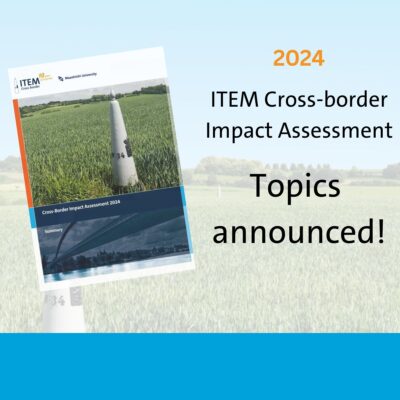The topics for the Cross-Border Impact Assessment 2024 have been selected and the research phase is progressing well. The final reports will be presented at the ITEM annual conference on 22 November 2024.
ITEM’s main task is to help remove border barriers within the EU. We therefore publish a detailed annual report on what we consider to be current issues from legislation and policy that could raise such barriers. These include, for example, barriers for people who live in one country but work in another, or barriers that prevent local authorities from collaborating on cross-border projects. By identifying and analysing these topics, ITEM aims to contribute both to the scientific debate and to the improvement of (policies on) cross-border mobility and the socio-economic development of border regions in practice.
This year’s topics:
1. Opportunity analysis: European cross-border impact assessment and cohesion policy for border regions
Articles 174 and 175 TFEU stress the importance of territorial cohesion in addition to social and economic cohesion. Nevertheless, the status quo regarding the development of border regions is not enough. On the one hand, the development of border regions is not adequately addressed and facilitated, on the other hand, policies do not sufficiently take into account the position of border regions. The European Commission’s 2021 Communication ‘Joining forces to make better laws’ recognises the need to improve its own Impact Assessment by including, among other things, the perspective of border regions. It is also clear from the European Commission’s various Cohesion Reports that border regions have been hit disproportionately hard by COVID measures, among other things.
There is a certain ‘border blindness’, which calls for better place-based policy and legislation. For EU policies and legislation, there is an Impact Assessment Toolkit. One of the tools is the Territorial Impact Assessment, which however is not mandatory and therefore not always applied. With the ongoing renewals of the Cohesion Policy, this analysis looks at how EU policy can and should better take into account cross-border regions and which actors should be equipped to do so.
2. 2. Cross-border Impact Dossier: Facilitating Cross-border Solutions – proposed EU Regulation
On 14 September 2023, the European Parliament adopted a resolution for BridgEU: Border Regions’ Instrument for Development and Growth in the EU. On 12 December 2023, the European Commission published the proposal to amend the Regulation on a European Cross-border Mechanism (ECBM). The proposed Regulation will be updated to Facilitating Cross-border Solutions. During the Belgian Presidency, the proposal will also be followed up: “During its term, the Belgian Presidency will lead political debates on the future of Cohesion policy after 2027. The Presidency will prepare Council conclusions on the matter building on the 9th report on the Cohesion policy that will be presented by the Commission. In addition, the Presidency will organise discussions on the follow-up to the Commission’s amended legislative proposal on resolving obstacles to cross-border cooperation.”
The aim is to better address border obstacles and, potentially, provide ad hoc solutions. To this end, the regulation establishes national and/or regional Cross-border Coordination Points, designated for better structuring of border obstacles. This case study assesses the effects on border regions in Europe. Some countries already have collaborations and structures, others do not yet. How does the impact differ between border regions? Together with TEIN partners, several border regions are examined and compared.
TEIN collaboration with:
- Euro-Institut Kehl/Strasbourgh
- WSB University, Poland
- Carinthia University of Applied Sciences, Austria
- CESCI, Hungary
- University of Ljubljana, Slovenia
3. 3. Cross-border Impact Dossier: Benelux Police Treaty
On 1 Oct 2023, the new Treaty between Belgium, Luxembourg and the Netherlands on police cooperation entered into force (BENELUX Police Treaty for short). This happened more than five years after the treaty was signed in 2018. The treaty replaces the 20-year-old 2004 treaty on cross-border police action. The question is, in terms of border effects, can this treaty be seen as a particular milestone in border-regional crime fighting? Does it lead to more or better trans-regional cohesion in the border region? Does the treaty contribute to European integration in the area of societal security? How groundbreaking is the Benelux Police Treaty compared to, for example, the 2004 Benelux Police Treaty, the Prüm Treaty, or the Mutual Legal Assistance in Criminal Matters Treaty when it comes to border-regional cooperation in crime fighting? Will the Police Treaty be more effective in border regions than the latter agreements? Based on comparing the above-mentioned treaties, interviews with relevant experts and an analysis of parliamentary documents. Literature and media reports, an attempt will be made to answer the above-mentioned questions.
4. 4. Cross-border Impact Dossier: Cannabis-Gesetz
On 1 April 2024, the Cannabis-Gesetz is due to enter into force in Germany. The bill legalises cannabis under certain conditions, such as a limit of 25 grams and a maximum of three cannabis plants in the home. It should also allow sales under the umbrella of cannabis clubs. This dossier looks at the border effects of the Cannabis-Gesetz between Germany and the Benelux countries, with a focus on the Netherlands and Belgium. What does this mean for Dutch border municipalities and coffee shops, for example? How do the Netherlands-Germany border regions compare with Belgium-Germany? A multidisciplinary PREMIUM team of master students is conducting the research.
5. Cross-border Impact Dossier: The Impact of recent EU legislation in the field of EU industrial policy on border regions
In dit dossier wordt de impact van het EU-industriebeleid op grensregio’s beoordeeld. Het analyseert de huidige EU-strategieën op het gebied van industriebeleid en in het bijzonder de recente wetgevingsvoorstellen waarover is onderhandeld.
- This dossier will assess the impact of EU industrial policy with a view on border regions. It will analyse the current EU strategies on industrial policy and in particular the recently negotiated legislative proposals.
- European Commission, Proposal for a regulation establishing a framework for ensuring a secure and sustainable supply of critical raw materials, 16 March 2023, COM(2023) 160
- European Commission, Proposal for a Directive on Corporate Sustainability Due Diligence, 2022/0051 (COD) COM/2022/71 final
In December 2022, the European Council underlined the importance of an ambitious European industrial policy to make the economy fit for the green and digital transitions and reduce strategic dependencies. The Commission then tabled a communication entitled ‘A Green Deal Industrial Plan for the Net-Zero Age’ in February 2023 to speed up the net-zero transformation of industry and set Europe on the path towards climate neutrality. Accordingly, the Commission made a proposal for a “critical raw materials act” for the future of EU supply chains. New rules would aim to: increase and diversify the EU’s critical raw materials supply, strengthen circularity, including recycling, support research and innovation on resource efficiency and the development of substitutes strengthen the EU’s strategic autonomy. In February 2024, the Council and the European Parliament reached a provisional deal on the net-zero industry act. These new rules will facilitate the conditions for investments in green technologies by: simplifying permit granting procedures, supporting strategic projects, based on specific criteria contributing to decarbonisation, facilitating access to markets for net-zero technological products, defining rules for public incentives and enhancing the skills of the European workforce. The objective is to cover 40% of the EU’s needs in strategic technology products, such as solar photovoltaic panels, wind turbines, batteries and heat pumps.
On 23 February 2022, the Commission published a legislative proposal for a Directive on corporate sustainability due diligence. The proposal aims to foster sustainable and responsible corporate behaviour throughout global value chains. Companies would be required to identify and, where necessary, prevent, end or mitigate adverse impacts of their activities on human rights, such as child labour and exploitation of workers, and on the environment, for example pollution and biodiversity loss.
What are the specific effects of these proposals for industry in Dutch, German and Belgian border regions. Are there specific aspects that are positive or negative if it comes to industrial activities and investment close to the border and with respect to the business relation in the proximity?
6. Cross-border Impact Dossier: New Netherlands-Belgium tax treaty: an ex-ante assessment
On 21 June 2023, the Netherlands and Belgium signed the new tax treaty. This treaty replaces the 2001 treaty. The new tax treaty is important to prevent double taxation, combat abuse and it resolves some ongoing bottlenecks under the current treaty, including for teachers, professors and athletes and artists. However, other (long-term) bottlenecks, such as taxation of cross-border pensions and home working by frontier workers, have remained untouched. The treaty will be accompanied by a joint explanatory memorandum in due course. After that, the treaty can enter into force; that is expected to be in 2025.
This file looks at the ex-ante effects of the new tax treaty for the Dutch-Belgian border region.
The expertise centre ITEM (Institute for Transnational and Euroregional Cross-border Cooperation and Mobility) is active in the field of convergence of research, consulting, knowledge exchange and training activities in the field of cross-border mobility and cooperation.







